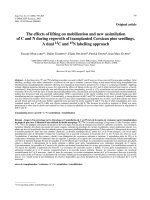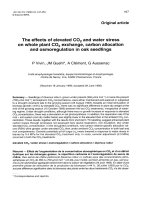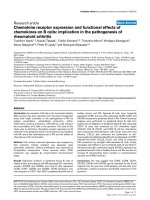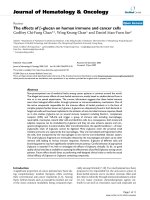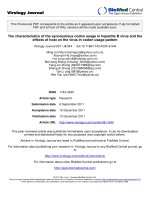Evaluating the effects of ecotourism on flora and fauna in ba vi national park, ha noi
Bạn đang xem bản rút gọn của tài liệu. Xem và tải ngay bản đầy đủ của tài liệu tại đây (822.54 KB, 47 trang )
MINISTRY OF AGRICULTURE AND RURAL DEVELOPMENT
VIETNAM FORESTRY UNIVERSITY
STUDENT THESIS
EVALUATING THE EFFECTS OF ECOTOURISM
ON FLORA AND FAUNA IN BA VI NATIONAL PARK, HA NOI
Major: Natural Resources Management
Code: D850101
Faculty: Forest Resources and Environmental Management
Student: Mai Thuy Van
Student ID: 1153090361
Class: K56 Natural Resources Management
Course: 2011 - 2015
Advanced Education Program
Developed in collaboration with Colorado State University, USA
Supervisor: Dr. Le Xuan Truong
Ha Noi, November 2015
ACKNOWLEDGEMENTS
First and foremost I offer my sincerest gratitude to Faculty of Forestry &
Environmental Management, Vietnam Forestry University for the continuous support of
my study and related research.
My sincere thanks also go to all of officers in Ba Vi national park, Ha Noi who
helped me with the field work and data collection. Without their precious support it would
not be possible to conduct this research.
My special thanks to my supervisor, Dr. Le Xuan Truong for his patience,
motivation, and immense knowledge. His guidance helped me in all the time of research
and writing of this thesis. I could not have imagined having a better supervisor and mentor
for my thesis. Besides, I also especially thank Prof. Lee MacDonald for assisting me in the
logical outline, structure and for valuable comments and discussions of final presentation.
Last but not the least, I would like to thank my parents and my friends for
supporting me spiritually throughout writing this thesis and my life in general.
Despite all efforts to make the study free from error, there may be errors still left
unnoticed for what the researcher takes all the responsibilities personally. I am very glad to
receive suggestions from my teachers and friends to make my thesis better, I sincerely pay
my thanks to them.
Ha Noi, November 2015
Mai Thuy Van
TABLE OF CONTENT
1/ Introduction ..................................................................................................................... 1
2/ Goals and Objectives ....................................................................................................... 3
2.1. Goals ............................................................................................................................... 3
2.2. Objectives ....................................................................................................................... 3
3/ Methods ............................................................................................................................ 4
3.1. Study area ....................................................................................................................... 4
3.2. Data collection ................................................................................................................ 5
3.3. Analysis data ................................................................................................................... 7
4/ Results and discussions ................................................................................................... 8
4.1. Current ecotourism activities in Ba Vi national park ..................................................... 8
4.1.1. Infrastructures and material facilities ...................................................................... 8
4.1.2. Current trend in tourism......................................................................................... 10
4.1.3. Seasonality in tourism............................................................................................ 12
4.2. Effects of ecotourism on flora and fauna in Ba Vi national park ................................. 12
4.2.1. Overview of tourists .............................................................................................. 12
4.2.2. Evaluating the awareness of tourists about the effects of ecotourism to Ba Vi
national park ........................................................................................................................ 14
4.2.3. Difference between nationalities about evaluation of the effects of ecotourism on
flora and fauna ..................................................................................................................... 22
4.2.4. SWOT analysis ...................................................................................................... 24
4.3. Suggest some solutions for sustainable management of ecotourism in Ba Vi national
park. ..................................................................................................................................... 26
4.3.1. About tourist .......................................................................................................... 26
4.3.2. About community .................................................................................................. 26
4.3.3. About manager....................................................................................................... 26
5/ Conclusions..................................................................................................................... 28
6/ References....................................................................................................................... 29
7/ Appendices ..................................................................................................................... 31
LIST OF TABLE
Table 3.1: The component of managers interviewed ............................................................. 6
Table 3.2: The structure of tourists by questionnaire ............................................................ 7
Table 4.1: Number of tourist from 2011 to 2014 in Ba Vi national park ............................ 10
Table 4.2: Nationality structure of tourist by questionnaire ................................................ 12
Table 4.3: Age and sex distribution of tourist ..................................................................... 13
Table 4.4: Sources of information let tourists know about Ba Vi national park ................. 14
Table 4.5: The purpose of tourism trip ................................................................................ 14
Table 4.6: The tourist density during the day ...................................................................... 15
Table 4.7: Awareness of tourists about influence level of ecotourism activities ................ 16
Table 4.8: Frequency of participation in tourism activities ................................................. 18
Table 4.9: Evaluating the positive and negative effects of ecotourism ............................... 21
Table 4.10: Awareness of tourists based on nationality ...................................................... 22
Table 4.11: Frequency of participation in tourism activities based on nationality .............. 23
Table 4.12: Evaluating the positive and negative effects of ecotourism based on nationality .. 24
LIST OF FIGURES
Figure 3.1: Local of study area .............................................................................................. 5
Figure 4.1: Organizational Structure of Ba Vi national park ................................................. 9
Figure 4.2: Ecotourism routes in Ba Vi national park ........................................................... 9
Figure 4.3: Number of tourist from 2011 to 2014 in Ba Vi national park ........................... 11
Figure 4.4: Age group distribution of tourists ..................................................................... 13
ABSTRACTS
The purpose of this research is to evaluate the effects of ecotourism on flora and
fauna in Ba Vi national park. The survey was conducted from July to September, 2015.
Data was collected from interview tourists and managers associated with field survey,
secondary data collection, SWOT analysis. Then evaluating the current potential of
ecotourism and exploitation in Ba Vi National park. Through interview questionnaire,
evaluate the awareness of visitors about the effects of ecotourism on flora and fauna. There
are some difference awareness between foreign visitors and domestic visitors. Finally,
suggest some solutions for sustainable management of ecotourism in Ba Vi national park.
1
2
1/ Introduction
Nowadays, the people‟ lives are improving. They want to travel to take a rest,
reduce daily anxiety. Moreover, they could breathe in the fresh air, immerse themselves
into nature, improve their knowledge. Thus, ecotourism has become the need of human
beings.
Ecotourism is a relatively new concept. It is the concern of a lot of people in
different fields. Ecotourism is now defined as "responsible travel to natural areas that
conserves the environment, sustains the well-being of the local people, and involves
interpretation and education" (The International Ecotourism Society (TIES), 2015).
Education is meant to be inclusive of both staff and guests. Principles of ecotourism
include: (i) Minimize physical, social, behavioral, and psychological impacts; (ii) build
environmental and cultural awareness, and respect; (iii) provide positive experiences for
both visitors and hosts; (iv) produce direct financial benefits for conservation; (v) generate
financial benefits for both local people and private industry; (vi) deliver memorable
interpretative experiences to visitors that help raise sensitivity to host countries' political,
environmental, and social climates; (vii) design, construct and operate low-impact facilities
and (viii) recognize the rights and spiritual beliefs of the Indigenous People in your
community and work in partnership with them to create empowerment (TIES, 1990).
In Vietnam, an important attraction of tourism is the biodiversity of the country.
Despite a great potential, ecotourism in protected areas and national parks in Vietnam in
general and at Ba Vi national park in particular is just at the beginning of development.
Ba Vi national park is centered on Mount Ba Vi, an isolated mountain about 50 km
west of Hanoi. The three mountain summits are Dinh Vua which is the highest at 1,296m,
Tan Vien which is 1,226m and Ngoc Hoa the lowest at 1,131m. Together they form a three
humped crest which is often obscured by clouds at the highest point. There are also superb
tropical forest views and vistas all the way to Hanoi to be enjoyed from this peak. The fast1
flowing Da River is located on one side of the national park; there are several other
streams running through the park. With the wonderful beauty, famous historical
monuments, waterfalls and streams, Ba Vi national park attracts a large number of tourists
each year. Moreover, Ba Vi national park has rich of forest resources, especially flora and
fauna. There are a lot of endemic and endangered species based on Vietnam Red data
book.
Tourists play the main part in ecotourism projects. Because of a great potential, the
number of tourists coming to Ba Vi national park has increased each year. In 2014, Ba Vi
national park welcomed nearly 150 thousands visitors, which increased 6.9% than the
number of visitors in 2013 (Environment Education & Services Center, 2015). But many
threats are caused by tourism. The effects of tourism are threatening flora and fauna, such
as noise, littering, exploiting forest products, illegal wildlife trade or building
infrastructures. Because most of activities are spontaneous, flora and fauna has been
degraded in many places. Some important income has been lost. The effects of ecotourism
on natural resources and conservation are necessary to concern today. After that researcher
should give some solutions, directions for ecotourism development as well as protect
potentials of the national park.
Because of the problems mentioned above, I decided to choose the topic:
“Evaluating the effects of ecotourism on flora and fauna in Ba Vi national park, Ha Noi” to
contribute development of ecotourism at the same time flora and fauna protection.
2
2/ Goals and objectives
2.1. Goals
Contributing to conservation of biodiversity and sustainable management of
ecotourism in Ba Vi national park, Ha Noi.
2.2. Objectives
The specific objectives of the research are:
1. to evaluate current ecotourism potential and exploitation in Ba Vi national park.
2. to evaluate the effects of ecotourism on flora and fauna in Ba Vi national park.
3. to suggest some solutions for sustainable management of ecotourism in Ba Vi
national park.
3
3/ Methods
3.1. Study area
Ba Vi national park was establish in December 18, 1991. The park is centered on
Mount Ba Vi - an isolated soil-limestone mountain situated about 50 km west from Ha
Noi. The mountain located in Ha Noi and shared the border with 2 districts of Hoa Binh
Province. Its coordinate systems are 20o55‟ -21o07‟ north latitude, 105o18‟ – 105o30‟ east
longitude. It has 10855 ha in area. The national park offers a great escape from the city
with cool fresh mountain air in a mystical atmospheric backdrop of clouds, jungle and
tropical rainforest. At Ba Vi national park, natural forest is mainly distributed at elevations
above 600 m. The natural forest types at Ba Vi are lowland evergreen forest, lower
montane evergreen forest and lower montane mixed coniferous and broadleaf forest. Ba
Vi national park is an area rich in biodiversity. There are a lot of endemic and endangered
species. Ba Vi supports 1201 species of vascular plant, of which several species were
described for the first time, such as Ixora balansae, Litsea baviensis and Lasianthus
langkokensis. There are 21 rare plants recorded in Vietnam Red data book such as
Calocedrus macrolepis, Madhuca pasquieri, Magliatia dandyi. The forest at Ba Vi
National Park is an important source of forest products for local communities. For
example, medicinal plant collection is a major economic activity in the area. The park also
supports 342 fauna species, including 63 mammal species, 191 bird species, 61 reptile
species and 27 amphibian species. Two endemic species are Tropidophous baviensis,
Chaparana delacouri. There are 66 rare species in Ba Vi national park such as Chrotogale
owstoni, Artictis binturong, Prionodon pardicolor. (List of flora and fauna, 2008).
Ba Vi national park also plays important contribution to conservation, natural
resources restoration, historical monument, research and tourism.
4
Figure 3.1: Locations of study area
3.2. Data collection
The surveys were conducted with 4 tourism transects in Tan Linh Commune,
located in Ba Vi district. Tourism transects must be through the forest which has rich of
flora and fauna. It also has a lot of tourists.
4 tourism transects are:
1. Flora garden in Coste 400
2. Upper temple (Đền Thượng)
3. French period summer camping
4. The old church.
All transects are determined on the map (Figure 4.2).
5
The equipment that I need to take my survey include: survey questionnaires,
notebook, pen, cameras, map and recorder.
In order to evaluate the effects of ecotourism on flora and fauna in Ba Vi national
park with more accuracy, participatory rural appraisal (PRA) techniques were applied. This
is a useful method to investigate ecotourism in the field. The actual information through
observation, listening and communication with tourists and local people, contribute to
evaluate objectively of thesis.
There are 3 steps to carry out the PRA methods:
First: Identify subjects and contents of investigation. The thesis is investigated with
2 main subjects are managers, tourists (Domestic and Foreign tourists)
Second: select survey methods. People will be interviewed through conversation.
Interview questions based on basic outline or survey questionnaires with the system of
multiple –choice questions and open-ended questions.
Third, after collecting data, statistically analyze the outcome data and various
indexes. Time for survey is also conducted randomly. Therefore, the information is
received diversified and objective.
There are many different approaches to conduct interview.
About managers: interview 8 people
Table 3.1: The component of managers interviewed
Position
Number
Director
1
Vice-director
1
Managers
3
Forest rangers
3
Managers were interviewed by semi-structure interview based on prepared
contents.
6
- About tourists: Tourists was interviewed by using questionnaire. As expected,
there could be 100 tourists, of whom could be 70 domestic tourists, of whom could be 30
foreign tourists. The samples were randomly selected. In fact, 70 domestic tourists and 10
foreign tourists were interviewed.
Table 3.2: The structure of tourists by questionnaire
Type of visitors
Domestic: 70
Foreign: 10
Age
From 16 to 55 years old
Education
Above secondary school
(Questionnaires are in the appendices)
3.3. Analysis data
Data and information from interview and survey questionnaires were analyzed by
using Microsoft Office software- Excel tool. The output I have shown is statistic the
personal information of tourists (age, sex, nationality); basic tourist indicators (information
of the destination, goal of tour), statistic and calculating the average and percentage of
activities, then evaluating the daily visitor density and the awareness of tourists about the
effects of ecotourism on flora and fauna in Ba Vi national park.
Using „SWOT analysis methods‟ to evaluate the strengths, weaknesses,
opportunities and threats of ecotourism in Ba Vi national park.
7
4/ Results and discussions
4.1. Current ecotourism activities in Ba Vi national park
4.1.1. Infrastructures and material facilities
4.1.1.1. Infrastructures
* Road system
The main road connected 87 highway to Coste 1100 is 13.7 kilometers length. The
main road was covered with asphalt. Pathways covered with concrete that were built inside
the park with 7.7 kilometers of total length. In general, the road systems are really good. It
is quite convenient for traveling.
* Electric system
Ba Vi national park has high- voltage and transformer station which supplies for
head office, collective zone, forest protection department, resort in Coste 400, flora garden
and local people.
* Information system
Mobile phone network has covered in the park. But when visitors go further into
forest, it is no phone service. Tourists can freedom access the internet in Coste 400 because
wireless was set up.
* Services system
Ba Vi national park has 3 restaurants, 1 swimming pool, 1 tennis yard, 1 souvenir
shop, 1 house on stilts, 3 guest houses, 2 car park, 1 conference room with capacity of 300
people.
8
4.1.1.2. Tourism management organization
Figure 4.1: Organizational Structure of Ba Vi national park
4.1.1.3. Ecotourism routes
Figure 4.2: Ecotourism routes in Ba Vi national park
(Source: Environment Education & Services Center, 2015)
9
There are 12 ecotourism routes:
* Spiritual tours
Route 1: Upper temple
Route 2: Ho Chi Minh president temple- Bao Thien tower
Route 3: Tan Vien pagoda – Medium temple
Route 4: Kho pagoda
Route 5: Ngoc Hoa cave
* French ruins tours
Route 6: French period summer camping
Route 7: The old church- Charity- school
Route 8: French period political prison
* Nature tours
Route 9: Flora garden
Route 10: Nature stream
Route 11: White stone wall- Old bear cave
Route 12: Old green cypress populations- Tieu dong peak
4.1.2. Current trend in tourism
In recent years, the influence of tourists has increased rapidly. However, it could be
threat of national park because pressure on natural resources is rising.
Table 4.1: Number of tourist from 2011 to 2014 in Ba Vi national park
Number
Foreign
Domestic
tourists
tourists
1527
110153
Year
Total
tourist
2011
111680
2012
124363
1612
2013
139601
2014
149195
%
Foreign
tourists
1.37
Domestic
tourists
98.63
122751
1.30
98.70
2345
137256
1.68
98.32
3171
146024
2.13
97.87
(Source: Environment Education & Services Center)
10
The table shows the total number of tourist in Ba Vi national park from 2011 to
2014 and the percentages of Foreign tourists and Domestic tourists.
Figure 4.3: Number of tourist from 2011 to 2014 in Ba Vi national park
The number of tourist has increased each year, and the percentage of foreign
tourists has increased too. But the percentage of foreign tourists is much smaller than the
number of domestic tourists. The percentage of foreign tourists is approximately greater
than 1% or 2%.
The number of visitors is increasing because of urbanization problems. Rapid
development can result in air and noise pollutions, so people want to come to some places
that have neglected natural resources, that surrounded by nature and fresh air. These places
are ideal for quiet rest and relax. Furthermore, ecotourism can raise awareness of people
about the value of natural resources, cultural history. On the other hand, spiritual tourism is
a strategic advantage of Ba Vi national park. Visitors can explore traditional religious
cultural values with a deep respect for historical heritage. The aims of tourists are camping,
studying, relaxing, spiritual tourism, etc. Some destinations attract tourists are Coste 400,
Upper
temple,
Ho
Chi
Minh
president
11
temple,
French
period
ruins.
4.1.3. Seasonality in tourism
Ecotourism activities in Ba Vi national park have specific seasons. There are two
high seasons each year. The first one is Tet holidays and after that, normally from February
to April. To them, this day has special auspiciousness and it holds propitious properties.
So, during these two months, they come to Upper temple, Ho Chi Minh president temple
or others temple or pagoda to pray safe and sound. They also discover natural. Tourists
usually stay for a short time, almost one day. The second high season is from June to
September. It‟s time for summer vacations. Almost visitors are young people. They choose
the destination for sightseeing, rest, research, etc.
4.2. Effects of ecotourism on flora and fauna in Ba Vi national park
When tourism activities newly began, the less use of resources was, the less
affected natural resource was. But if tourism is excessive development and the
conservation is not concerned, tourism activities may become the reason that damaged
natural resources. This is the current situation in protected areas and national parks in
Vietnam, especially Ba Vi national park.
In this thesis, there are two kinds of subjects: domestic tourists and foreign tourists.
Tourists were interviewed by answering questionnaire in appendices.
4.2.1. Overview of tourists
* The structure of tourist by questionnaire
Table 4.2: Nationality structure of tourist by questionnaire
Nationality
Number
Percentage (%)
Vietnam
70
87.5
Foreign
10
12.5
Total
80
100
80 visitors were interviewed by questionnaire. There were 70 domestic visitors
(87.5% of total interviewee) and 10 foreign visitors (12% of total interviewee). Among
12
visitors interviewed, there were 49 males (61.25% of total interviewee) and 31 females
(38.75% of total interviewee). The results are shown on table 4.3.
Table 4.3: Age and sex distribution of tourist
Nationality
Age
group
Vietnam
Foreign
Total
Number
Male
Female
Number
Male
Female
16-25
46
29
17
3
1
2
49
26-35
8
4
4
3
3
0
11
36-45
11
6
5
2
2
0
13
46-55
5
3
2
2
1
1
7
Total
70
42
28
10
7
3
80
The table shows the number male and female in each age group based on
nationality. Interview rate of each age group is different. The highest percentage is age 16
to 25 years (61.25%). Age group 26 to 35 years is 13.75%. Age group 36 to 45 years is
16.25%. The lowest percentage is age 46 to 55 years (8.75%). The results are shown on
figures 4.4 below.
Figure 4.4: Age group distribution of tourists
* Sources of information let tourists know about Ba Vi national park
13
Table 4.4: Sources of information let tourists know about Ba Vi national park
Sources of
information
Number of
interviewee
Friends,
relatives
Tourism
company
Advertising
Internet
58
7
5
10
%
72.5
8.75
6.25
12.5
From the table, we realize that tourists knew Ba Vi national park through different
sources such as their friends or relatives, tourism company, advertising or internet. Almost
tourist came to the park through their friends or relatives (72.5%). Other sources (tourism
company, advertising, internet) are limited. For succeeding in attracting tourists, the
destination countries should provide the necessary communication projects for
propagation.
* The purpose of tourism trip
Visitors came to Ba Vi national park with different purposes. The results are shown
on the table 4.6.
Table 4.5: The purpose of tourism trip
Purpose
Relax
Sightseeing
Spiritual
tourism
Study and
research
Other
Number of
tourists
18
40
9
13
0
%
22.50
50
11.25
16.25
0
In fact, the most crowded visitor route is spiritual tourism such as Upper temple,
Ho Chi Minh president temple. The tourism routes have crowded visitor with sightseeing
aim are Coste 400, French period summer camping, the old church, Coste 1100. Most
tourists often travel in small groups of 2 to 5 people. For the group of student, they often
travel in group of 20 to 30 people. Almost tourists did not book a tour and need the tour
guide. Tourism was spontaneous natural.
4.2.2. Evaluating the awareness of tourists about the effects of ecotourism to Ba Vi
national park
14
* Evaluating the tourist density during the day in Ba Vi national park
Evaluating the daily tourist density in Ba Vi national park is an important part of
research. Based on the tourist density, the effects of ecotourism on flora and fauna could be
predicted. High density might make harmful effects to flora, fauna and vice versa. The
results of tourist‟s opinion about the tourist density during the day are shown on the table
below.
Table 4.6: The tourist density during the day
Number
of tourist
Not at all
(1)
Tourist density during the day
Slightly Moderately Considerably Extremely
(2)
(3)
(4)
(5)
80
5
9
40
24
2
%
6.25
11.25
50
30
2.5
Average
3.11
The values of each level are different, so the concentration levels of tourist are
unequal. Each level was graded: 1: Not at all crowded, 2: Slightly crowded, 3: Moderately
crowded, 4: Considerably crowded, 5: Extremely crowded. Then average value of all
levels was calculated. The average equals 3.11 which shows the tourist density during the
day is moderately crowded.
* Evaluating tourist’s awareness about the influence level of ecotourism activities on
conservation of flora and fauna in Ba Vi national park
It is important to evaluate the awareness of tourists about the conservation of flora
and fauna. Then the effects of ecotourism on flora and fauna could be evaluated. The
results of survey are shown on the table 4.8:
15
Table 4.7: Awareness of tourists about influence level of ecotourism activities
Level (Point)
Not at
all (0)
Slightly
(1)
Moderately
(2)
Extremely
(3)
Average
Walking on grass, plant, breaking
branch
27
38
11
4
0.90
Tree, Stone carving
60
20
0
0
0.25
Buying souvenir of forest
products
25
22
25
8
1.20
Campfire
44
24
12
0
0.60
Eating forest products
35
16
18
11
1.06
Exploiting forest products
46
23
11
0
0.56
Illegal wildlife trade
55
16
9
0
0.43
Noise
18
16
29
17
1.56
Littering
27
18
24
11
1.24
Building infrastructures
27
33
16
4
0.96
Activities
Look at the average grade of each activity, we know the influence level of this
activity on conservation of flora and fauna. The high average grade is, the more flora and
fauna resource are affected and vice versa.
Through the table 4.8, the awareness of tourists about influence level of ecotourism
activities on conservation of flora and fauna is limit. Almost activities were evaluated from
„Not at all effect‟ to „Slightly effect‟.
Activities were affected in „Not at all effect‟ (Average grade < 1) by tourists
includes: Tree, Stone carving (0.25); Illegal wildlife trade (0.43); Exploiting forest
products (0.56); Campfire (0.60); Walking on grass, plant, breaking branch (0.90);
Building infrastructures (0.96).
16
Activities were affected in „Slightly effect‟ (1< Average grade < 2) by tourists
includes: Eating forest products (1.06); Buying souvenir of forest products (1.20); Littering
(1.24); Noise (1.56).
In fact, according reports of Ba Vi national park associated with interview
managers and communities, some activities were extremely happen such as noise, littering,
building infrastructures, exploiting forest products. Rubbish was thrown by tourists that
observed from field survey was nylon pocket, bottle, paper, tin cans. It affected the
landscape of national park. Smoke from wood fires could affect air quality and may affect
animal‟s health. Careless use of campfires is one of the leading causes of forest fires.
Building infrastructures and roads changed terrain, surface flow, caused loss of vegetation
cover. In addition, animal was impacted by noise from machines, transport vehicle. In the
field trip in Ba Vi national park from July to September, 2015, a new guest- house was
built on Coste 400. But convenient roads in the park created condition for communities to
violate the natural resources. It is easily to set a trap or hunt animal, bird; exploit bamboo
shoot, reed, wood or medicine plants. After that, visitors ate and bought forest products.
Visitors said that they had eaten wild boar, bamboo, pip banana, tonic. When tourists
discovered the natural tour, they often took orchid, flower or tree brank. On the other hand,
after completing work, it raises the mission of forest protection in national park,
contributes to ecotourism development, attracts tourists, and makes opportunities to
business.
When author asked tourists about chances to see wildlife, they almost did not see
any animal. Some animals were observed such as bird (Pycnonotidae, Leiothrichidae,
Sturnidae), butterfly or insect. Because Ba Vi national park have not had fauna protection
area, tourists could not see other animal in forest. It proclaims the living space of animal
was narrowed. They only lived in deep forest where little effect of human had.
17



